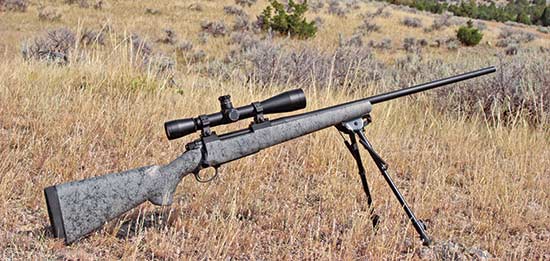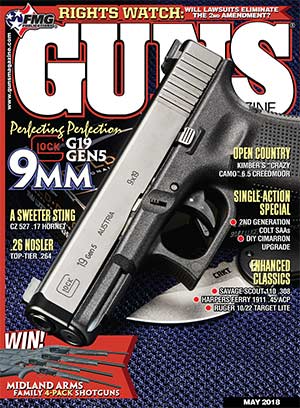Super 6.5
Forget The Creedmoor! the .26 Nosler Is The True Long-Range Round
When the .26 Nosler cartridge was announced in late 2013, some older hunters wondered why we needed a hot 6.5mm, when America’s other “magnum” 6.5 cartridges hadn’t been any more successful than New Coke.
The .264 Winchester and 6.5 Remington Magnums, introduced in 1959 and 1966, never grabbed much market share, because back then 99 percent of American hunters didn’t care. We’d finally accepted 6mm and 7mm cartridges, but apparently weren’t interested in an oddball European caliber between the honest American .25 and .270. Most deer hunters were already happy with the cartridges already available, and hunters after bigger game wanted heavier, larger-diameter bullets, to compensate for mediocre bullet construction.
High BC Benefit
Even American target shooters didn’t start really comprehending the benefits of the high ballistic coefficients of 6.5 bullets until the 1990s. Eventually some hunters followed their lead, because 6.5mm bullets had higher BCs than .25 or .270 bullets. Eventually the trend resulted in the 6.5 Creedmoor, the most successful new centerfire rifle cartridge in the 21st century.
However, many hunters still believed high muzzle velocity was essential to open-country big game cartridges, because it flattened trajectory over “normal” ranges, making sure hits easier. Between the 6.5mm trend and the belief in extra zip, the .264 Winchester Magnum started making a comeback.
However, one of the .264’s dirty little secrets was it never quite achieved the claimed 3,200 feet per second of the original 140-grain factory load, at least at pressures the shooting industry considers safe. I discovered this myself after purchasing a couple of .264s, one an original Model 70 “Westerner” with a 26-inch barrel. Many new-age shooters also sneered at the .264’s old-fashioned belted case.
The .26 Nosler solved both problems. Like many other new-age magnums it has a belt-free case, and (like the .264) fits into any bolt-action suitable for the .30-06, including the “long” version of Nosler’s Model 48. It also holds around 10 percent more powder than the .264, so can easily get 3,200 fps with 140-grain bullets, and with some powders 3,300.
However, like all cartridges with lots of powder capacity for their caliber, the selection of suitable powders is limited, and those that really perk up even more limited. My rifle’s a synthetic-stocked Nosler Model 48 Liberty, with a 26-inch, 1:8-inch twist barrel. While I’ve tried a number of slow-burning powders, so far only two resulted in a combination of accuracy and velocity providing a noticeable advantage over the .264. While not as accurate as the average 6.5 Creedmoor, my rifle is accurate enough for big game at extended ranges, particularly because the additional 500 to 600 fps possible over the Creedmoor reduces wind-drift even more, especially with 140-grain bullets.
It also works well with somewhat lighter bullets at even zippier velocities, pleasing traditional hunters who prefer a super-flat trajectory to twirling their scope’s elevation knob. Nosler’s original factory load, the 129-grain AccuBond Long Range at a listed 3,400 fps, provides exactly this sort of performance. When sighted-in for an old-fashioned 3 inches high at 100 yards, the bullet lands 5 inches low at 400 yards in typical Montana hunting conditions.
The Loads
In my rifle, the factory velocity is duplicated with 82.0 grains of Ramshot Magnum, using Nosler brass with CCI 250 primers, with 129 ABLR’s seated to the same overall length as the factory load, 3.400 inches. However, my handloads shoot a little more accurately than Nosler’s factory ammo, with 3-shot groups averaging 0.66 inch. The same powder charge also works well with the 127-grain Barnes LRX, for similar accuracy.
With 140-grain bullets, 87.0 grains of Hodgdon US869 matches the advertised 3,300 fps of Nosler 140- and 142-grain ammo. Mostly I’ve used the 140 AccuBond and Partition, seated with the same setting on my Redding die, resulting in an overall length of 3.365 inches for the plastic-tipped AccuBond and 3.330 inches for the Partition. Believe it or not the Partitions are slightly more accurate, averaging 0.70 inch, while the AccuBonds average 0.86 inch.
Hodgdon claims US869 is temperature resistant, and it proved to be when I shot this load at both 70 degrees and zero Fahrenheit, losing only 24 fps. Ramshot doesn’t make the same claim for Magnum, but it only lost 32 fps in a similar test.
When the .26 Nosler was announced, many shooters predicted barrels would only last a few hundred rounds. At the moment I’ve fired my Liberty 292 times, and while some throat erosion is visible through my Hawkeye bore-scope, the rear of the rifling is still sharp. Nosler reports most rifles go at least 1,000 rounds before accuracy starts to fall off. Recoil isn’t bad at all, similar to a typical 7mm magnum with 160-grain bullets.
The .26 Nosler is everything the .264 Winchester claimed to be, plus a little more. It’s a fine compromise for both traditional open-country hunters wanting a flat trajectory, and 21st-Century turret-twirlers looking to minimize wind-drift, the reason Nosler’s specialized 6.5 is holding its own in the increasingly crowded 6.5 marketplace.
John Barsness’s Big Book of Big Game Hunting can be ordered through
www.riflesandrecipes.com/, P.O. Box 579, Townsend, MT 59644, (406) 521-0273.







